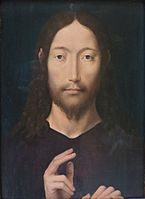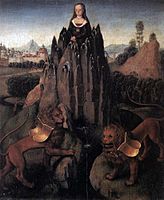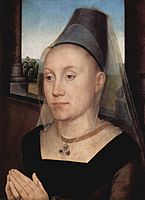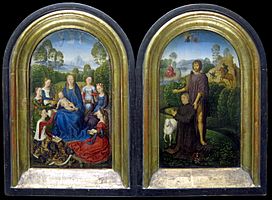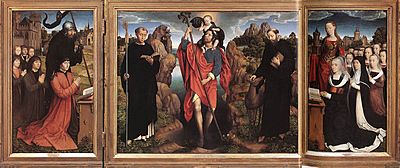Hans Memling facts for kids

Hans Memling (also spelled Memlinc; born around 1430 – died 11 August 1494) was a famous painter from the Flanders area. He was part of the Early Netherlandish painting style. Hans was born in Germany, probably in Mainz. Later, he moved to the Low Countries and worked in Brussels with another well-known artist, Rogier van der Weyden.
In 1465, Hans Memling became a citizen of Bruges, a busy city in Belgium. He became one of the most important artists there. He had a big workshop where he painted many religious artworks. These often included portraits of the wealthy people who paid for the art. Memling's customers included burghers (like bankers, merchants, and politicians), church leaders, and rich families.
Memling's portraits were very popular and built on the styles he learned when he was young. He became very successful. In 1480, he was even listed as one of the richest people in Bruges. He married Anna de Valkenaere between 1470 and 1480, and they had three children. People rediscovered Memling's art in the 1800s, and it became very popular again.
Contents
Life of a Famous Painter
Hans Memling was born in Seligenstadt, a town near Frankfurt in Germany. He probably learned to paint as an apprentice in Mainz or Cologne. Later, he moved to the Low Countries (which are now Belgium and the Netherlands). He worked in Brussels from about 1455 to 1460 with the famous painter Rogier van der Weyden. By 1465, Memling was working in Bruges, in the area known as County of Flanders.
Important Artworks and Commissions
Memling painted for the Hospitallers (a religious order) in Bruges in 1479 and 1480. He was already known to them before 1477. In 1477, people thought he had died. But he was actually working on a large altarpiece for the booksellers' guild in Bruges. This altarpiece, called Scenes of the Passion of Christ, is now in a museum in Turin, Italy.
Another famous painting is The Last Judgment. It has been in Gdańsk, Poland, since 1473. This painting was ordered by Angelo Tani. He was in charge of the Medici Bank's branch in Bruges. When the painting is closed, it shows Tani and his wife praying. Tani ordered this altarpiece for a chapel in Fiesole, Italy. The painting was shipped to Italy, but a privateer (a type of pirate) from Gdańsk captured the ship in 1473. This shows that Memling was already very famous.
Working with Rogier van der Weyden
There is clear evidence that Memling worked with Rogier van der Weyden. Some old records from 1524 mention a three-part painting (a triptych) by Rogier van der Weyden. The parts with angels were painted by "Master Hans," which was Memling. He might have been an apprentice to van der Weyden in Bruges.
One altarpiece shows how closely they worked together. It was ordered by a rich family called Sforza. The middle part, showing the Crucifixion, looks like van der Weyden's style. But the side parts look like Memling's work. For a long time, people debated who painted which parts.
Memling's Portrait Style
Memling's portraits were very popular, especially in Italy. He was known for using beautiful landscape backgrounds in his portraits. These backgrounds often had a good balance between the top and bottom, and the front and back. For example, a person's head might be against a plain sky, while their shoulders had lively details of the landscape behind them.
Memling's portrait style influenced many Italian painters in the late 1400s. You can see his influence in paintings like Raphael's Portraits of Agnolo and Maddalena Doni. Rich Italian customers, like cardinals and the Medici family, loved his work. His art was appreciated not just in Italy and Flanders, but also in other places.
Later Works and Success
Memling's painting Scenes from the Passion of Christ in Turin and Advent and Triumph of Christ in Munich show a common style in Flanders. Artists would paint many different scenes from a story on one large picture. They would cover a wide area with events from the Passion of Christ, like a play.
Around 1492, Memling was asked to paint a large altarpiece for a monastery in Nájera, Spain. This altarpiece showed God surrounded by angels playing music. It was finished in Flanders.
Memling became quite wealthy. In 1480, his name was on a list of the 875 richest citizens in Bruges. These citizens had to lend money to Maximilian I of Austria to help pay for wars. However, Memling's name didn't appear on later lists. This suggests that his money might have decreased during a tough economic time in Bruges in the 1480s.
One of Memling's greatest later works is the Shrine of St Ursula. It is in the museum of the hospital in Bruges. It was likely finished in 1480. The tiny figures, varied landscapes, and amazing detail in this work are truly enjoyable to see. Other later works include St Christopher and Saints (1484) and the Diptych of Maarten van Nieuwenhove.
Near the end of his career, Memling got more help from his workshop. Records from the painters' guild in Bruges show that two apprentices worked with Memling and joined the guild in 1480 and 1486.
Hans Memling died in Bruges. Records from 1495 show that he left behind several children and a good amount of property.
Memling Carpets
There are four paintings by Memling that show a special kind of oriental carpet. These include the triptych with the Virgin and Child Enthroned (in Vienna) and the triptych of John Donne (in London). These carpets have a pattern that repeats over and over. It looks like an old design from Turkoman carpets made in Central Asia.
These types of carpets are now named after Memling and are called Memling carpets. They are known for their "gul" designs. Guls are patterns with "hooked" lines that spread out from a central shape.
Images for kids
-
The Man of Sorrows in the arms of the Virgin, 1475, National Gallery of Victoria
-
Christ Giving His Blessing, 1478, Norton Simon Museum
-
Mater Dolorosa, c. 1480, Uffizi Gallery
-
Annunciation, 1480–89, Metropolitan Museum of Art
See also
 In Spanish: Hans Memling para niños
In Spanish: Hans Memling para niños





